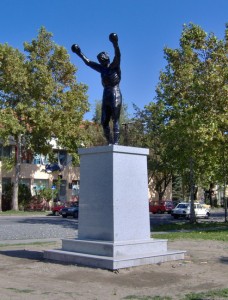![]() Rocky’s resonance through the ages is paralleled by few other films. The rough and tumble Philadelphia boy seems to be the pinnacle of icons for the down-and-out, the under-achieved, under-represented, the gritty real people, whose lives aren’t glossy like Good Housekeeping covers depict. Rocky plucked himself out of obscurity and, quite literally, fought his way to the top (only after a humbling loss in Rocky I). He is the every-man’s underdog. He’s a dim-witted, fourth-rate, club fighter with no particular distinction, but he manages to embody optimism and courage (Leab, 265).
Rocky’s resonance through the ages is paralleled by few other films. The rough and tumble Philadelphia boy seems to be the pinnacle of icons for the down-and-out, the under-achieved, under-represented, the gritty real people, whose lives aren’t glossy like Good Housekeeping covers depict. Rocky plucked himself out of obscurity and, quite literally, fought his way to the top (only after a humbling loss in Rocky I). He is the every-man’s underdog. He’s a dim-witted, fourth-rate, club fighter with no particular distinction, but he manages to embody optimism and courage (Leab, 265).
The reason for Rocky’s resonance beyond a bicentennial United States icon is to do with his relatability. As such, his image has been lifted and utilized many times, in many countries, making the Italian Stallion more than just an American idol but also an international icon.
Stamp collectors had the opportunity to enjoy the mangled-up Stallone face on 5 sets of limited edition stamps released in 1996 bringing fact to Rocky’s own line: “Yo, is this a face you can trust? Someday, they’ll put this face on a stamp.”
The fact that Rocky’s face was lifted for the 5 countries (Ghana, The Gambia, Uganda, St. Vincent and Grenadines, and Grenada) was explained as: “Rocky Balboa stands for the average guy who wants to lead a decent life and be the best he or she can be. The Philadelphia club boxer symbolizes everyone who has at anytime in their life been faced with seemingly impossible obstacles and yet refused to just give up” (Daniel Keren, Total Rocky). Each country felt an affinity for the man who nearly won, and each country boasts “more Rocky fans than America,” according to the article published on Total Rocky.

In 2007, Serbian city Žitište erected a statue dedicated to the fighter. The subject of a documentary, Amerika Idol by Barry Avrich, the statue was revealed to be the hope of the city to counteract the misfortunes of the past 4000 years. The statue is thought to bring “inspiration,” and “tourism dollars,” as reviewer Robert Bell points out. Bell also states that the residents believe Rocky will be a good role model for the youth and also stands as the “universal representation of the underdog.” Rocky as the symbol of luck, a waypoint for wayward youth, and the ultimate underdog has been utilized by town.
“When they’re cheering for Rocky, they’re cheering for themselves,” seems to be the most apt description of Rocky uttered by the man himself Sylvester Stallone (Leab, 271). It’s Rocky’s ability to appeal to the every-man that makes him so relatable. He stands for the underdog and embodies the emotions of courage, bravery, and pluck (which we could all use a bit of sometimes). As such, Rocky’s image has become the symbol of fight, of determination, and of strength in the face of adversity.
So, why Rocky? Because he’s every man, every person, the common man… he’s one of us. His appeal crosses borders, but his message remains the same. Go get it, and don’t give up.
Sources:
Daniel Leab, “Reaffirming Traditional Values,” Hollywood’s America.
http://www.imdb.com/title/tt1347302/
http://totalrocky.com/articles/five-nations-honor-stallone.html
http://exclaim.ca/film/article/amerika_idol_true_story-directed_by_barry_avrich